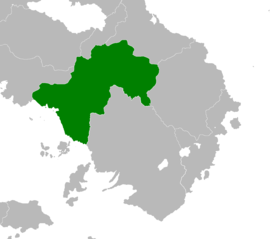Western Kingdom of the Levantines
This article is a work-in-progress because it is incomplete and pending further input from an author. Note: The contents of this article are not considered canonical and may be inaccurate. Please comment on this article's talk page to share your input, comments and questions. |
Western Kingdom of the Levantines Regnum Levantorum Occidentalis | |||||||||
|---|---|---|---|---|---|---|---|---|---|
| 917–978 | |||||||||
 West Levantine Kingdom after Brian III's succession in 917 | |||||||||
| Capital | Colgar | ||||||||
| Common languages | Old Carnish Old Ænglish Carnish Gaelic limited use of Gallawan and Latin in official and church matters | ||||||||
| Religion | Catholic (official) Germanic religion | ||||||||
| Government | Monarchy | ||||||||
| Western King of the Levantines | |||||||||
• 917–947 | Aemon the Unworthy (first) | ||||||||
• 947–978 | Lorcan the Last (second and last) | ||||||||
| Historical era | Middle Ages | ||||||||
| 917 | |||||||||
| 978 | |||||||||
| Currency | Siller | ||||||||
| |||||||||
| Today part of | |||||||||
The Western Kingdom of the Levantines (Latin: Regnum Levantorum Occidentalis) or the Western Levantine Kingdom was a successor state of Conchobar's Levantine Empire created by the empire's division among the three sons of Emperor Brian III in 917. The western kingdom was given to Brian III's youngest son, Aemon, who ruled the kingdom until his death in 947. It would then be inherited by Aemon's only son, Lorcan, who would rule the kingdom until 978 when the now greatly diminished realm was dissolved after Lorcan was captured during a rebellion by the kingdom's Carnish and Gaelic vassal lords.
In 995, Duncan, petty king of Dunaird, succeeded in uniting the numerous Carnish lords under his rule. With the Carnish lords once again united under a single ruler, Duncan founded the Kingdom of Carna, becoming its first king and beginning more than a millennia of independent Carnish rule. The founding of the Kingdom of Carna caused Lorcan's eldest son, Brian, to abandon his claim to the lands west of the newly reformed Levantine Empire, recognising that any attempt to re-establish the Western Levantine Kingdom would now be unlikely to succeed.
Brian III's succession
In 917, on his deathbed in Corcra Abbey, Emperor Brian III decreed that upon his death the Levantine Empire would be divided equally among his three sons, as was the Gaelic custom. The eastern portion of the empire was left to the eldest son, Culmann, the southern portion of the empire, which was made up of the former heartland of Great Levantia, was left to the middle son, Charles, and the western portion of the empire was left to the youngest son, Aemon.
Aemon would rule the Western Kingdom of the Levantines until his death at the age of 51 in 947. Despite his efforts to establish himself as a strong authority over the Western Levantine Kingdom, Aemon's rule was seen as weak by the kingdom's Ænglish Carnish and Gaelic vassals, who had chafed under the rule of Conchobar's Levantine Empire and had no love for his descendants. Aemon's rule was marred by raids from the Ænglish tribes over the kingdom's western border. After capturing Aemon's wife, Daracha, during a raid on the outskirts Colgar in 943, the Ænglish raiders were granted a large swathe of land near the kingdom's eastern border in exchange for Daracha's release. Despite nominally ruling this region as vassals of the Western Levantine Kingdom, Aemon was unable to exercise any real authority over the region's new Ænglish rulers. Aemon's deal with the Ænglish raiders and his inability to establish his authority over their new lands only cemented Aemon's status as a weak king in the eyes his Carnish and Gaelic vassals.